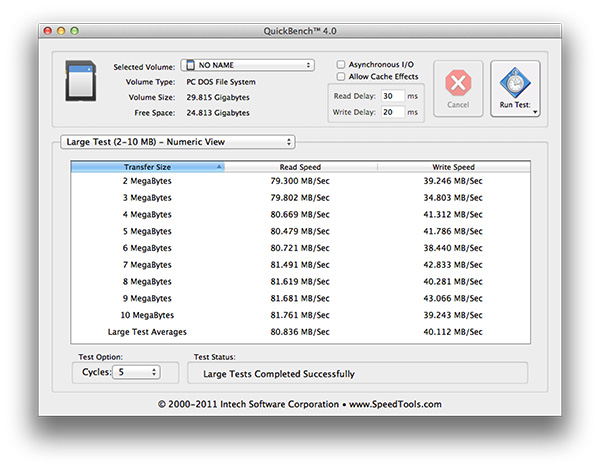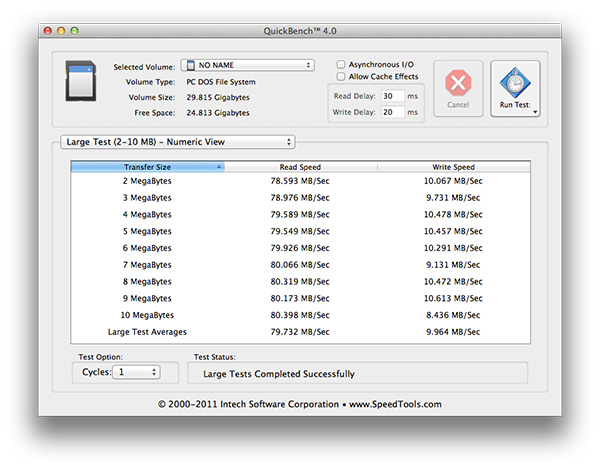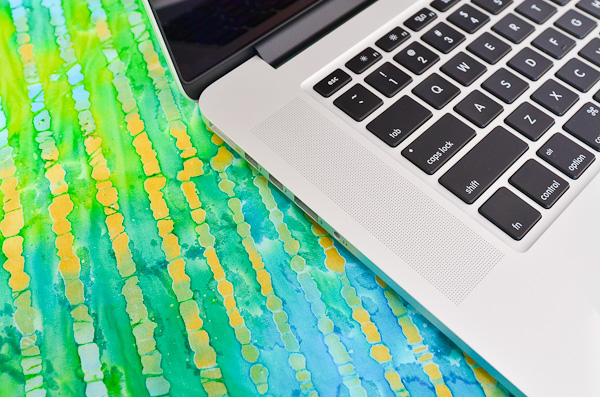The next-gen MacBook Pro with Retina Display Review
by Anand Lal Shimpi on June 23, 2012 4:14 AM EST- Posted in
- Mac
- Apple
- MacBook Pro
- Laptops
- Notebooks
WiFi Performance
The next-gen MacBook Pro is equipped with a decidedly this-gen wireless stack. In other words it uses the same 3x3:3 WiFi solution that was present in the 2011 MacBook Pro and is present in the non-Retina 2012 MacBook Pro as well: Broadcom’s BCM4331. The wireless behavior characteristics are a bit different since this is a physically different chassis, but we’re still dealing with a 3-stream 802.11n solution - not 802.11ac. All three antennas are located in the Retina Display’s housing.
We have seen Apple be conservative with component choices in the past. Deciding to stick with Samsung’s 45nm LP process for the A5X instead of embracing 32nm LP sooner with the 3rd gen iPad is one example that comes to mind. Like a good silicon company Apple appears to mitigate risk in design by sticking with known-good components wherever possible. Major changes to the industrial design are typically paired with comparatively minor silicon changes, and other components are kept as static as possible so long as they don’t overly compromise experience. While 802.11ac dongles and routers are just arriving today, Apple likely froze the Retina MBP’s wireless configuration quite a while ago. Rather than be caught shipping potentially unratified hardware, Apple went the safe route and stuck with 802.11n.

That’s not to say Apple’s wireless implementation is bad. The 15-inch MacBook Pro has been one of the best behaved notebooks on wireless that I’ve had the pleasure of using. The MacBook Pro with Retina Display is no different. Just like before, the best case negotiated physical rate is 450Mbps when paired with a 5GHz 3x3 access point. Unobstructed, within a couple of feet of the AP, I measured as much as 230Mbps to the Retina MacBook Pro. I tested at three different distances from the AP, through walls and on both 2.4GHz and 5GHz bands. Overall performance seemed comparable to the standard 15-inch MacBook Pro, although it’s definitely faster in some areas and slower in others.
| Location 1 | Location 2 | Location 3 | |
| 2011 MacBook Pro (2.4GHz) | 124.0 Mbps | 12.6 Mbps | 61.6 Mbps |
| Retina MacBook Pro (2.4GHz) | 117.9 Mbps | 87.6 Mbps | 44.0 Mbps |
| 2011 MacBook Pro (5GHz) | 186.8 Mbps | 154.6 Mbps | 24.7 Mbps |
| Retina MacBook Pro (5GHz) | 227.7 Mbps | 156.8 Mbps | 33.7 Mbps |
The second test location consistently performed poorly on the 2011 MBP, only on 2.4GHz however. For the most part there were no real surprises otherwise.
The SD Card Reader
It was our own Brian Klug who clued me into the horrible behavior of the 2011 MacBook Pro’s SD card reader. Depending on the SD card used, the integrated SD card reader either performed admirably or was the most frustrating part of the Mac experience. Out of the three SD cards I frequently use: a Patriot LX series card, a Transcend and a new UHS-I Patriot EP Pro, only the Transcend card actually works remotely well with the 2011 chassis. Even then, it’s not perfect. I usually have to insert and remove the card at least once before the reader will recognize it. The LX and EP Pro on the other hand are measurably worse. To get the EP Pro to work in the 2011 MBP’s reader I usually have to push the card in then apply upward or downward force to the exposed edge of the card to get it to read properly. Even then it’ll usually disappear from OS X or be present but read at bytes per second. I doubt this is the fault of the card itself but rather the latest example of incompatibility with the horrible SD card reader in last year’s MacBook Pro.
At least with the cards I’ve tested, the Retina MacBook Pro exhibits none of these issues. Over dozens of insertions I had no issues reading from or writing to all three of these cards, including the problematic ones. I ran a Quick Bench test on the EP Pro as it’s the fastest of the lot and came away with reasonable performance as well. Roughly 80MB/s reads and 40MB/s writes. The numbers are shy of Patriot’s 90/50 spec but quite good.
One of the times I was able to get the EP Pro working in the 2011 MacBook Pro I managed to squeeze in a single Quick Bench run. Read performance was almost identical at 80MB/s, but write performance was far lower at only 10MB/s:
Shortly after the test completed I could no longer write to the drive in the 2011 MBP so I suspect the card reader was acting up again. Needless to say, if you like using SD cards with your MacBook Pro the Retina Display model appears to be much better. That’s not to say there couldn’t be other incompatibilities, but in everything I tested it looks like this problem is finally fixed.
Better Speakers and Dual Mics
Apple is proud of its new speaker design in the Retina MacBook Pro. There’s not a whole lot you can do for tiny laptop speakers but despite shrinking the overall volume of the chassis, Apple has managed to deliver much better sound out of the new speakers in the rMBP. Like most of the upgrades to the next-gen MacBook Pro, you really need to do an A/B comparison to appreciate the difference. And keep your expectations in line with reality, a good set of external speakers are always going to sound better. With that said, the new speakers definitely deliver a fuller, more rich sound than their predecessor. You can still tell you’re listening to some form of integrated speakers, but now they sound distinctly less like they’re coming from a inside a notebook.
In preparation for Mountain Lion's arrival with dictation support, Apple outfitted the next-gen MacBook Pro with dual microphones in order to better focus on your spoken voice and not on background noise. In practice the new mics work reasonably well, rejecting moderate volume background noise. Loud music nearby will still cause interference and as always, accurate dictation requires more than just good quality source audio to get right.













471 Comments
View All Comments
Fx1 - Monday, June 25, 2012 - link
Whine Whine Whine.In the UK we have the best warranty going thanks to UK Regulations and EU protection. Plus 3 year free on education discounts of which i have bought 2 MBP's and never set foot in a university in my life.
Just because in NZ you don't have that protection then blame your gov for not passing legislation.
Also why bitch about Ram? just put the 16GB in and then your good for the next 10 years i expect. £13 a year cost
Spunjji - Tuesday, June 26, 2012 - link
You're so full of shit it's bursting out at the seams. The NZ government have imposed much better consumer warranty protection than we have here in the UK. You might know that if you weren't a fucking cretin who spouts off nonsense before thinking. The fact that you seem to think it's his fault that he lives in NZ where Apple give shitty support just shows what a jingoistic little fanboy you are.That's also an interesting "£13 a year" theory. It'd be neat if it wasn't a complete and utter crock. If more than 10% of these laptops are used regularly for 10 years, Apple pixie magic included, then I will eat my goddamn chair. Maybe you should have gone to university, they could have slammed some sense into your tiny little skull.
Solidstate89 - Sunday, June 24, 2012 - link
"Apple’s impact on the industry has already been felt. The threat of Apple bringing Retina Displays to its entire lineup forced ASUS’ hand and gave us 1080p IPS panels in the new Zenbook Primes."Isn't that a little fucking arrogant to say with absolutely no proof to back that claim up? You know better than anyone how much design work goes into producing these products, and just how LONG the process takes. You really think in just a few months time of rumors, ASUS could have completely revamped their product line-up? Or maybe they were just doing it, because they had already started with the higher resolution displays on their tablet line-up? Or maybe they were even trying to match the absolutely superb and high density display that Sony has been using in their Vaio Z series for all these years.
Claiming just the RUMOR of Apple doing it was UNDOUBTEDLY the influence behind ASUS' IPS, high resolution screens is baseless bullshit. And you know it.
Iketh - Sunday, June 24, 2012 - link
what i don't get is how people could care so much to get pissed off like you... get a hobby!and i agree 100% with Anand's statement... you're blind to not agree, and i'm a PC developer
wfolta - Sunday, June 24, 2012 - link
ASUS may have decided to carry higher resolution displays from their tablets to their laptops, but Apple beat them to the punch with the retina iPad and the rumors of a retina Macbook have been around since at least that far back.Considering most manufacturers have reduced pixel density over time, and considering it was Apple that pushed the retina display first to the iPhone, then the iPad, I think the burden of proof is on you to say that these netbook makers were just itching for higher resolution.
In fact, most of them stopped at the stupid 16:9 1080p (1920x1080) resolution because that's what HD TVs have and they've wanted to tout their ability to play BluRay's at full resolution. There was no concept of making a beautiful display: it was all about a marketing checkbox. And that's what they guy is saying.
kmmatney - Sunday, June 24, 2012 - link
I'm a windows developer - have been for almost 20 years now. I also travel a lot so all my development is done on a laptop, across several virtual machines. I'm currently using a 2007 Dell 17" 1920 x 1200, and have not upgraded yet, waiting for another windows 1920 x 1200 laptop to surface. I've run out of hope now - if Apple comes out with a 17" version of this I'll have to try and convince my company to buy one. I've never used a Mac in my life, but will pay the "Apple tax" to get what I need hardware-wise. I currently have about 20 VMs packed onto a Samsung 256GB 830, so I'm good with storage space.The Windows laptop makers just don't get it - not everyone watch's movies all day - some of us want to use our machines for real work and want to have extra vertical space. Is it that hard to make a 16:10 screen? An ugraded screen is a "3D" screen - really?! The "True-life" screen on my old 2007 Dell is still better than anything you can get nowadays - I've directly compared it with co-corkers brand-new laptops.
KPOM - Sunday, June 24, 2012 - link
Is it possible that Apple's solution for making the rMBP work will scale to the new iPhone? In other words, does it offer Apple a way to increase the screen size without causing a break in compatibility between older and newer apps?gstrickler - Sunday, June 24, 2012 - link
The iPhone and iPad already handle the HiDPI displays, Apple deployed Retina displays there first. The scaling to non integer resolutions is definitely something Apple could do on the iPhone or iPad, but since it takes significantly more CPU/GPU power and affects both performance and battery life, I would not expect it anytime soon. If Apple goes to a larger screen on either device, it's likely that it will support the same total resolution as the current devices and have slightly lower dpi. If we see a 3.7"-4.3" iPhone display, I expect it to be 960x640, just like the current iPhone with Retina display.They already have 4 native resolutions to support on iDevices, 480x320 and 960x640 on iPhone, 1024x768 and 2048x1536 on iPad. I don't believe they'll want to increase that as it has an impact on the hardware, battery life, and every developer, so while it's possible, I think it's unlikely.
raclimja - Sunday, June 24, 2012 - link
Ingadgethrrmph - Sunday, June 24, 2012 - link
This one is *extremely* close to allowing me to replace a full tower workstation and my current laptop. Apple has built a very, very impressive machine that should be a wake-up call to the industry: Move forward, or be left behind.Even so, it falls slightly short of my ideal specs. If Apple would make the next one a 17" or 18" version (please make it Retina, I love the foresight there :), add a 10-Key section to the keyboard, upgrade to Giga-WiFi-ac-1.3Gbs, upgrade the quantity of internal drive ports (yes plural - I can use up to 5 immediately, if they will fit), and pretty please give us a standard drive connector.
While we're at it, can we have all of the drives running at speeds of at least 6.0Gbs? You know, like putting the drives on the current standard mSATA 6.0Gbs connectors, or even hooking them up to a better, newer, smaller, open standard connector at 12.0Gbs.
That's a lot to ask of course, but if they 'just' managed to make it a 17" Retina display, with three drives, with standard connectors, and WiFi-ac-800Mbs, and managed to do it this year, then I would feel they have done as much as anyone could do in in the time available.
If they miss out on delivering a 17" model this year, then it becomes more of a wide open competition where almost anyone could deliver a competitive product in the 17"+ space. After all, the display actually only has to be better than 1920 x 1200 to exceed the specs of my current laptop display.
Right now Apple appears to have the hardware lead and a fairly big one at that. If such a 17"+ machine appears, as described in any of the scenarios above, then it would solidify Apple's hardware lead. With a move like that, Apple would firmly and aggressively cement its position in every laptop screen size category that matters. They could have a compelling position in perhaps 99% of the laptop market.
It would also satisfy my need to have a portable large display machine that can go on infrequent, but very long trips, where I am sometimes remote, and I often need to be fairly self-sufficient and fault tolerant (ie: fix any of the inevitable data glitches myself).
It would improve my situation very significantly if there were sufficient physical drives to have separate system, data, and auto-backup drives internally. Also, having extremely capable external ports is important. So both keeping the existing wired ones just released on the current 15" Retina model, and adding the nascent WiFi-ac wireless internal hardware that is debuting this year in non-Apple equipment, would be super helpful for enhancing my ability for doing redundant off-machine data backups - just in case the internal auto-backup gets thrashed.
In fact if Apple were able to produce such a machine, I would be virtually forced - in a very pragmatic sense - to shell out the cash, move to the dark side, and purchase my first Apple product, ever.
Yes, after 25 years of computing I would lose my patience with the laggards that comprise the rest of the laptop market. With deep, naughty feelings of dark misgiving, I would both splurge and switch allegiance at the same time. I wonder how many others would do the same?
If this should come to pass, then I would inevitably wonder if Apple's real intentions are as wicked as I fear: To eventually try to lock all of us as 'sheeple', into a proprietary hell on Earth. You know... like Sony's thankfully failed attempts to force 'works only here' on us. Umm... let's see... MMC Memory Sticks, anyone?.
Well, back to Apple: Just sayin'... I would do it... even though I know better.
Hey... isn't Microsoft supposed to be getting back into the hardware business in a big way?
What do you think the chances are of a company like Microsoft and a machine like that...
So you're telling me there's a chance... *YEAH!*
-